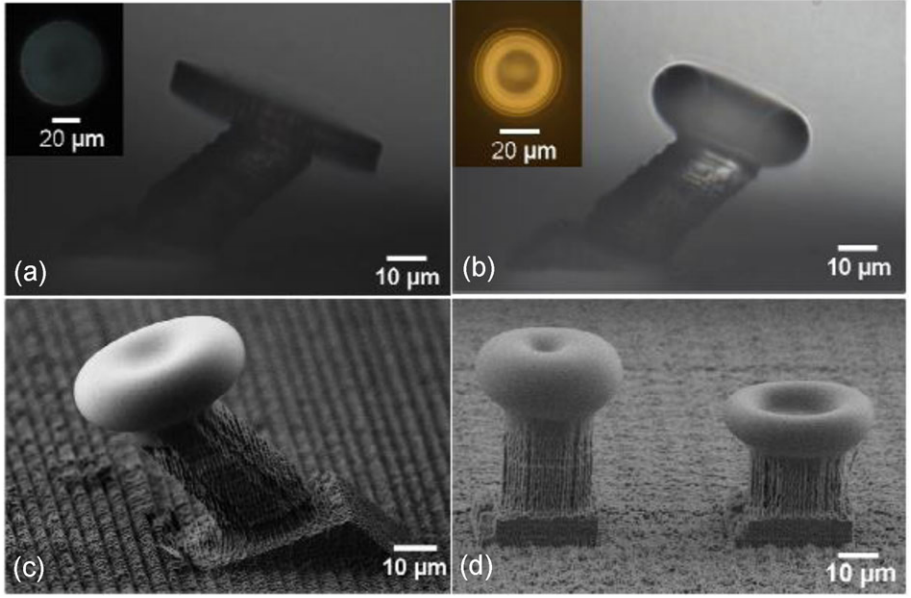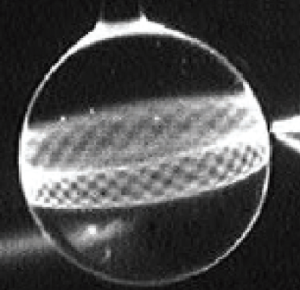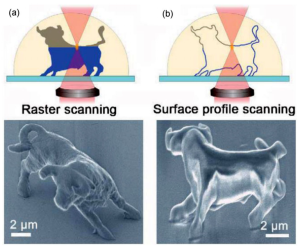Whispering-gallery modes are the phenomena of waves traveling along the curve of a concave surface without degrading. The concept was first explained by Lord Rayleigh in 1878 as he explained the effect that produced traveling whispers in St. Paul’s Cathedral. Because the sound waves cling to the curved walls, they don’t decay as they would against square walls, but actually continue for a much greater distance, making even whispering sounds audible all around the gallery. And it isn’t just sound waves that follow this unique dispersal pattern, the process has also been observed for radio waves, microwaves, ultraviolet waves and light waves.
Huailiang Xu and Hongbo Sun from Jilin University State Key Laboratory on Integrated Optoelectronics recently published a paper called “Femtosecond laser 3D fabrication of whispering-gallery-mode microcavities“. The paper demonstrates a method of utilizing femtosecond (extremely fast and small) laser 3D printing to create whispering-gallery-mode microcavities that will confine light inside of them. The process will be useful for a wide variety of micro-scale technologies like micro-lasers, micro-sensors and micro-filters. The process could be one of the basic building blocks of integrated photonic systems which could lead to the development of advanced micro-scale data processing technologies.
Femtosecond laser direct writing (3D printing) has been a hotly researched technology in recent years. A femtosecond laser pulses so rapidly than the pulses are measured at the rate of one quadrillionth, or one millionth of one billionth, of a second. The pulsing speeds make these lasers capable of creating extremely small features in photosensitive materials, similar to stereolithography only much smaller with a significant increase in detail. The process is being researched for several varieties of technologies, ranging from micro-fluidics, optoelectronics, micro-electronics, micro-machines, micro-sensing, to micro-biomimetics and micro-optics. However using the process to fabricate high quality whispering-gallery-mode microcavities to trap light waves is a new area of research that could lead directly to breakthroughs in advanced quantum data storage and processing.
Xu and Sun’s review article offers a brief introduction on the basic principles of femtosecond laser processing. Then they move on to the use of high-quality micro-fabrication using the femtosecond laser processing technique to generate micro-scale 3D structures in the photosensitive polymer material. They also discuss their success in fabricating 3D passive and active whispering-gallery-mode microcavities using several varieties of polymers as well as glass and crystal structures. They also introduced the process of fabricating an integrated micro-sensor device with a whispering-gallery-mode microcavity.

Optical microscope images of fused silica microdisks fabricated by femtosecond laser processing and chemical wet etching
“It is believed the further effort on the investigation of femtosecond laser 3D fabrication of high-Q factor microcavities will undoubtedly benefit the applications of microcavities in a broad spectrum from bio-sensing and optoelectronics to quantum information,” explained the pair of researchers in their paper.
While the research being conducted here is exciting news for the possible development of high-peed and high-volume data processing and storage devices, it is still too early to determine how practical the process will be. Not only is the process still quite challenging, but Xu and Sun still need to demonstrate that fabricating these high quality microcavities using femtosecond laser direct writing will have usable applications. The review paper has been published in SCIENCE CHINA Physics, Mechanics & Astronomy, volume 58, Issue 11.
Subscribe to Our Email Newsletter
Stay up-to-date on all the latest news from the 3D printing industry and receive information and offers from third party vendors.
You May Also Like
Wisconsin’s Evology Adds Digital Sheet Forming to Service Roster
Evology, a service bureau based in Wisconsin and specializing in serving strategic sectors like aerospace and defense, has added digital sheet forming (DSF) to its repertoire of manufacturing capabilities. Evology...
Boring Company Alum Score $9M for Advanced Composites Manufacturing
Layup Parts, a Huntington Beach, CA-based startup specializing in on-demand manufacturing of parts made from composites, has received $9 million in its latest financing round. Founders Fund, the VC firm...
Industrial Giant Ingersoll Rand Leads $19M Round Backing Inkbit’s AI-Driven 3D Printing
Inkbit, the Massachusetts-based original equipment manufacturer (OEM) of multi-material, AI-integrated 3D printers, has closed a $19 million financing round. Ingersoll Rand, a US giant in the industrial equipment sector, led...
3YOURMIND & Nigerian Oilfield Services Firm RusselSmith Team Up on 3D Printed Part Inventory
3YOURMIND, the German and U.S. software services provider specializing in digital inventory platforms for additive manufacturing (AM), has partnered with Nigerian oilfield services firm RusselSmith to digitize spare part files...



































